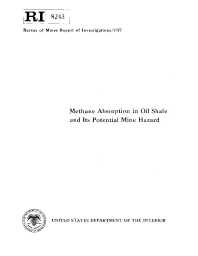Mining Publication: Methane Absorption in Oil Shale and Its Potential Mine Hazard
Original creation date: January 1977
The Bureau of Mines made laboratory absorption measurements on oil shale samples, which showed that the amount of methane absorbed is proportional to pressure and oil yield, and can be much larger than would be predicted based solely on porosity. Oil shale cores collected in the field were also measured for their gas content using the Bureau of Mines direct method. Cores taken from deep locations and far from outcrops yielded more gas than cores from shallower locations or at outcrops, when taking into account variations in oil yield, and all data indicate that oil shale mines that are both deep and far from an outcrop will emit low levels of methane gas.
Authors: JE Matta, JC LaScola, FN Kissell
Report of Investigations - January 1977
NIOSHTIC2 Number: 10000618
Pittsburgh, PA: U.S. Department of the Interior, Bureau of Mines, RI 8243, 1977 Jan; :1-13
See Also
- Investigation of Methane Emissions From an Advancing Face in the Belle Isle Domal Salt Mine, Louisiana
- Methane Content of Gulf Coast Domal Rock Salt
- Methane Contents of Oil Shale From the Piceance Basin, CO
- Methane Control by Isolation of a Major Coal Panel - Pittsburgh Coalbed
- Methane Diffusion Parameters for Sized Coal Particles: A Measuring Apparatus and Some Preliminary Results
- Methane Emission from U.S. Coal Mines, A Survey
- Methane Emission Rate Studies in a Northern West Virginia Mine
- Modeling and Prediction of Ventilation Methane Emissions of U.S. Longwall Mines Using Supervised Artificial Neural Networks
- Reservoir Rock Properties of Coal Measure Strata of the Lower Monongahela Group, Greene County (Southwestern Pennsylvania), from Methane Control and Production Perspectives
- Technology News 465 - Method for Predicting Methane Emissions on Extended Longwall Faces
- Content source: National Institute for Occupational Safety and Health, Mining Program


 ShareCompartir
ShareCompartir
